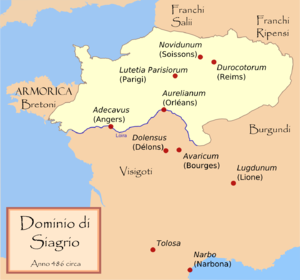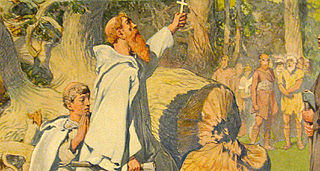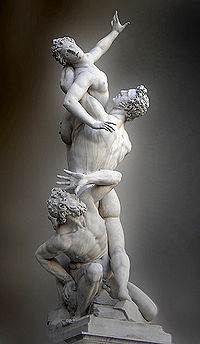Our story
This Chapter
|
|
 October 9, 2011 Throughout the fifth century, the Salian Franks lived fairly harmoniously alongside the Catholic Gallo-Romans. Helping things along was their military alignment in several conflicts. Both, Franks and Romans, were more concerned about other Germanic tribes such as the Arian Visigoths. This may have been a factor in Clovis's affiliation with Catholic Christianity. True, Clovis put an end to Roman dominance in Gaul by defeating, in 486, Syagrius, a Roman ruler in much of northern Gaul, which, one would think, ought not to endear him to the Romans. But Syagrius was considered a rogue, ruling independently over an area Gregory of Tours called "The Kingdom of Syagrius." ¶ 4  The "Kingdom of Syagrius." To the north, we see the regions of the Salian and the pagan Ripuarian Franks; to the south the region of Arian Visigoths. (Source.) ¶ 4 Another factor in Clovis's Catholic leanings may have been the support of an authoritative Gallo-Roman, Catholic episcopate at a time when the imperial administrative system within Gaul was deteriorating and the Roman clergy, descended from aristocratic Gallo-Roman families, became the preeminent local administrators. Today, academics surmise that the episcopate, threatened by Arian tribes, was looking for a champion with clout whereas a young Clovis was seeking to expand his dominion. This combining of interests, it turned out, led to an episcopcy increasingly populated with persons appointed by Clovis's Merovingian successors. This nibbling away at the ecclesiastical power structure under papal direction was accompanied by another development. ¶ 5 Under Roman law, a community, church, or corporation possessed the right of owning property so that all the wealth of the local congregations was the property of the church. Following the infiltration of the barbarians, Roman law was substituted, in some cases, with Germanic law. Germanic law and custom dictated that churches could and should be owned by individuals, and this policy was imposed upon the Christians. The income derived by the church—whether it be from tithes, offerings, or fees levied by priests for administering the sacraments—became the personal income of the proprietor.* Properties held by churches and monasteries had no economic obligations to the secular world. Well-to-do estate holders, therefore, found it attractive to establish them within their own domains while maintaining administrative and economic control. A noble or a bishop, couched his or her foundation-charter in terms of outright gifts—I donate ... for ever—but in the same documents, strings were often attached, notably the requirement to commemorate the founder. The precise-sounding Roman-legal terms were in practice vague, and contestable. If founder's right came down to appointing the abbot, it was less a matter of law than of the reality that the monastery had been founded for or by one who wished to rule it. And so was it that those propretiary churches and monasteries provided the aristocracy with enhanced stature and final resting places with continued prayers for their souls. Monasteries with their praying workforces were especially attractive. Otherwise, neither kings nor aristocrats did care much about their subjects' religious beliefs as long as they observed the Church's rituals. ¶ 6 Gregory II, pope from 715 to 731, wishing to evangelize "the wild nations of Germany" tasked the Anglo-Saxon missionary Boniface with this effort, bidding him, by, as the Catholic Encyclopedia put it, "the irrefragable authority of Blessed Peter, to 'go forth and preach the truths of both Testaments'." Problem was how. Boniface was advised to proceed "not offensively or so as not to anger them, but calmly and with great moderation. At intervals you should compare their superstitions with our Christian doctrines, touching upon them from the flank, as it were, so that the pagans, thrown into confusion rather than angered, may be ashamed of their absurd ideas, and may understand that their infamous ceremonies are well known to us." The advice continues, "This point is also to be made: if the gods are all-powerful, beneficient, and just, they not only reward their worshippers but punish those who reject them. If then they do this in temporal manners, how is it that they spare us Christians who are turning almost the whole earth away from their worship and overthrowing their idols? And that while these, that is, the Christians, possess lands rich in oil and wine and abounding in other resoources, they have left to those, that is, the pagans, lands stiff with cold where their gods, driven out of the world, are falsely supposed to rule." ¶ 7  In this 1905 renderring by Emil Doepler, Boniface cuts down a sacred oak tree devoted to the Germanic war god Donar, to us better known as Thor. Descriptions by peoples in contact with Germanic tribes reveal a widespread devotion to sacred trees, groves, springs, and stones, as well as an interest in prophecy and magic. (Source.) ¶ 8 Stories abound how Boniface put this advice into practice. At one point, he confronted Germanic pagans at a site with a sacred oak tree devoted to Donar, their god of war. The pagans agreed that he challenge Donar to strike him down with a bolt of lighting for chopping down his tree. When Boniface began to fell the tree, he was suddenly aided by a strong wind to finish the job. Convinced, the pagans turned to Christianity and the wood was used to build a chapel. Another story tells how Boniface stopped pagans from sacrificing a boy with a hammer blow by splitting the hammer with his bishop's crook. ¶ 9 How, really, did our pagan forefathers perceive the world? The Roman historian Tacitus gave an extensive description of how he, back in the first century CE, perceived the Germanic tribes, see Chapter 7, ¶ 21 for some detail. It is interesting to compare his observations of how the Germanic tribes behaved with an attempt by George Dumézil to peek into the Germanic and, indeed, in the entire Indo-European mindset. Dumézil did this by comparing the myths of Indo-European peoples from Iceland to India and found them to be by-and-large cut from the same cloth, a weave that substantially differs from that of non-Indo-Europeans.* Their deities can be divided into two groups, the Aesir and the Vanir who are, simply put, the warriors and the life-givers. In the Germanic version, the first group includes the sky-god Odin (or Wodan) and the hammer-wielding, thunder-rattling god of war Thor (or Donar). The second group includes the god and goddess of fertility Freyr and Freya, brother and sister. Of course, names have changed, and so did details, paralleled with changes in social structure and customs (such as using Donar's hammer for human sacrifice). Dumézil and collegues subscribed to the view of that "religion is something eminently social" because "religious representations are collective representations that represent collective realities."* ¶ 10  "The Rape of the Sabine Women" (1574—82) by Giambologna, in the Loggia dei Lanzi in Florence. Actually, the title was assigned after this work's completion. (Source.) ¶ 11 As Indo-European tribes moved far and wide away from their original habitat, they blended with with others like ocean waves rolling over one another as they lap the shore, in the process absorbing habits of action and thought as reflected in the Aesir overpowering the Vanir; warriors raiding herding and farming tribes. The Aesir-Vanir duality of Indo-European mindset is a deep-seated one, going back some five millennia, to well before Germanic tribes becoming inhabitants of what we now call Europe. A broadly comparable example of that duality is the story of the rape of the Sabine women, which ancient Roman writers elevated to history and supposedly happened some 27 centuries ago. The first three Roman kings collectively are felt to represent sovereignty and force, whereas the conquered Sabines represent fecundity, thereby making a tripartite society of spiritual leaders, mighty warriors, and providers. ¶ 12 Quoting from my primary source for this chapter*, James C. Russell's The Germanization of Early Medieval Christianity, "Another 'uniquely Indo-European phenomenon', which is more relevant to the subject at hand, was the existence of 'a class of military specialists whose prime purpose was to exercise physical prowess, either in defense of the society or in order to conquesr new territory'. Members of this class of military specialists usually organized themselves into a comitatus or Männerbund [band of men], 'a band of young warriors led by a chief or king which was distinct from the other strata of society (i.e. the priests and the cultivators) and which exhibited in battle a remakable recklessness and esprit de corps'. The comitatus figured 'among the most prominent features of ancient Indo-European social organization." Three transgressions for which a warrior hero will not ever be forgiven are "regicide, a crime against the social function of sovereignty; cowardice, a violation of the warrior ethic of the second function of force; and adultery, a violation of the third function of fecundity." ¶ 13 Bibliography
|
--
| top of page |
|
Page maintenance:
Page format:monh xx, 2015
Story edit:
To be checked for timeliness:
¶ none
Reminders:
¶ none
Linkcheck: not done
XHTML verify: not done
Backups: month. 25, 2011
